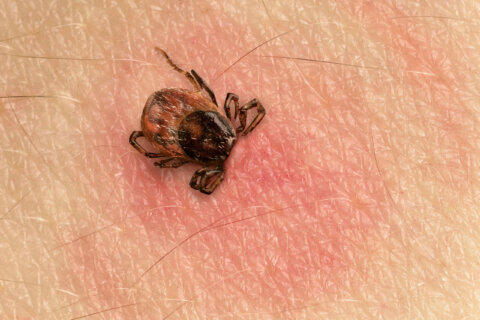This article is part of the WTOP series, “Facing Down Fentanyl: Teens Confront Drug Danger.”
Even as rates of fatal drug overdoses remain alarmingly high, experts say the vast majority of deaths are preventable.
More than three out of five overdose deaths involved at least one instance in which the person could have received help before overdosing, or received lifesaving help during an overdose. That’s according to the Centers for Disease Control and Prevention.
The missed opportunities are, in part, due to a fear that other drug users who seek help for someone suffering from an overdose could be prosecuted.
That’s not necessarily the case in the D.C. region. Maryland, D.C. and Virginia all have so-called “good Samaritan” laws on the books that protect those who help someone in need.
“Even if they’re using drugs, if they have a friend who is overdosing … if they call the police and ask for help and they stay with that person, that they won’t be prosecuted for their own possession,” said Fairfax Commonwealths Attorney Steve Descano about the commonwealth’s good Samaritan laws.
“We want to keep people alive,” Descano said.
Virginia has seen a dramatic rise in overdose deaths among people 18 years of age and younger over the past three years. In 2019, the state saw 11 overdose deaths and in 2022 the total was 36, according to Virginia Department of Health.
In 2022, 18 of those overdose deaths happened in northern Virginia.
While there are individuals who choose to do nothing to help someone suffering an overdose, others who do try to help may go to great lengths to avoid interacting with first responders, especially police.
Across the Potomac in Montgomery County, Maryland, State’s Attorney John McCarthy said his office has footage of this unfolding at hospitals.
“You’ll see a car slow down about 5 miles an hour, outside the emergency room doors of a hospital, in ‘Anywhere USA,’ — and including Montgomery County — and they’ll slow down, and they’ll slowly push somebody out the back door, or the side door of the car, depositing them on the steps of the emergency room,” McCarthy said.
That’s why McCarthy said his office shows these videos at high schools, when encouraging them to instead call 911, administer naloxone if they can and wait with person in need until help arrives.
“We’re trying to educate people, but also encourage that if you’re there, in those precious moments, when you can save another person’s life to do it with no fear of repercussions from us in terms of criminal justice,” McCarthy said.
Using the courts to force treatment
Another area where the law can come into play, when helping someone with a substance use disorder, is using the courts to force a loved one to go into a recovery program.
Around the D.C. region, using that legal avenue is complicated.
In Virginia, if parents feel they have done all they can do to try and get their child into recovery and have reached “wit’s end,” they can file a petition in juvenile Domestic Relations Court seeking the courts help in getting a child into treatment, Descano said.
But if a child is an adult, concerned parents don’t have a similar option at their disposal.
“What I can tell you is unlike when a minor comes in with a drug issue, or has a drug issue, unfortunately, they’re very likely to end up as an adult on my desk, due to a criminal case,” Descano said.
But he said his office works to help those brought in on drug possession charges get the help they need.
In Maryland, on the other hand, there are no options for parents to involuntarily commit a minor for drug treatment, McCarthy said.
When it comes to involuntarily committing both minors and adults, legislation in Maryland has been introduced in recent years. But concerns that stem from the so called “mental asylums” seen in the early 1900s has many hesitant to move forward with a law that would allow for involuntary commitment in Maryland.
McCarthy said parents of both minor and adult children are asking for a legal way to get their children help, and he said maybe a logical first step would be to begin with a law like Virginia’s that pertains only to minor children, and later extend it to adults.
“You’re literally watching your child slowly commit suicide with these drugs and they’re desperate to try to do something,” McCarthy said of parents.
Regina LaBelle, director of the addiction and Public Policy Initiative at Georgetown University Law Center’s O’Neill Institute, said while D.C. also offers situations in which courts can force someone into treatment, she cautions against that route, if it all possible.
“If it’s not a quality treatment facility, which it may not be — there aren’t enough quality treatment facilities, particularly for juveniles — you could be re-traumatizing that child and making their condition worse,” LaBelle cautioned.
She recommends that parents start with local resources available, as well as national websites such as Partnership to End Addiction and Shatterproof, which can provide support for parents seeking help for their child.
Read more from the series “Facing Down Fentanyl: Teens Confront Drug Danger”
- Are fentanyl test strips the answer to stopping more deadly overdoses?
- Unseen and unheard: Unique Maryland high school aims to help students beat addiction
- The small blue pills behind a surge in children’s fentanyl-related hospital visits in the DC area
- ‘Not my child:’ What a mother says you need to know about teens and fentanyl
- Md. school system races to battle fentanyl epidemic facing teens








